
Columbidae is a bird family consisting of pigeons and doves. It is the only family in the order Columbiformes. These are stout-bodied birds with short necks, and short slender bills that in some species feature fleshy ceres. They primarily feed on seeds, fruits, and plants. The family occurs worldwide, but the greatest variety is in the Indomalayan and Australasian realms.

The European turtle dove is a member of the bird family Columbidae, the doves and pigeons. It breeds over a wide area of the south western Palearctic including north Africa but migrates to northern sub-Saharan Africa to winter.

The large bird genus Columba comprises a group of medium to large pigeons. The terms "dove" and "pigeon" are used indiscriminately for smaller and larger Columbidae, respectively. Columba species – at least those of Columba sensu stricto – are generally termed "pigeons", and in many cases wood-pigeons. The rock dove ,has given rise to the majority of domesticated pigeon breeds, such as the racing pigeon and the fantail pigeon some of which have become feral. Meanwhile, "wood pigeon" by itself usually means the common wood pigeon.
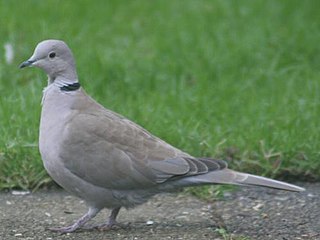
Streptopelia is a genus of birds in the pigeon and dove family Columbidae. These are mainly slim, small to medium-sized species. The upperparts tend to be pale brown and the underparts are often a shade of pink. Many have a characteristic black-and-white patch on the neck and monotonous cooing songs.
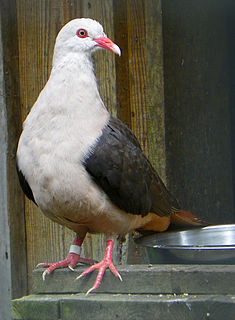
The pink pigeon is a species of pigeon in the family Columbidae endemic to Mauritius. The pink pigeon nearly became extinct in the 1990s and is still very rare. It is the only Mascarene pigeon that has not gone extinct. It was on the brink of extinction in 1991 when only 10 individuals remained, but its numbers have increased due to the efforts of the Durrell Wildlife Conservation Trust since 1977. While the population remains at below 500 birds as of 2011, the IUCN downlisted the species from Critically endangered to Endangered on the IUCN Red List in 2000, and then downlisted it again to Vulnerable in 2018.

The Raphinae are a clade of extinct flightless birds formerly called didines or didine birds. They inhabited the Mascarene Islands of Mauritius and Rodrigues, but became extinct through hunting by humans and predation by introduced non-native mammals following human colonisation in the 17th century. Historically, many different groups have been named for both the dodo and the Rodrigues solitaire, not all grouping them together. Most recently, it is considered that the two birds can be classified in Columbidae, often under the subfamily Raphinae. The first person to suggest a close affinity to the doves was Johannes Theodor Reinhardt, whose opinions were then supported by Hugh Edwin Strickland and Alexander Gordon Melville.
The Réunion pink pigeon is an extinct species of pigeon that formerly lived on the Mascarene island of Réunion. It is known from the description of a rusty-red pigeon given by Dubois in 1674 and a single subfossil humerus that agrees with that of the pink pigeon of Mauritius in generic characteristics, except being slightly longer. Also, Dubois' reference to the bill being red at the base and the eyes being surrounded by a red ring suggest that this species was closely allied to the Mauritus taxon. Dubois' description was as follows:
wild pigeons, everywhere full with them, some with slaty-coloured feathering [Alectroenas?], the others russet-red [N. duboisi]. They are a little larger than the European pigeons, and have larger bills, red at the end close to the head, the eyes ringed with the colour of fire, like pheasants. There is a season when they are so fat that one can no longer see their cloaca [croupion]. They are very good tasting. Wood-pigeons and turtle-doves, as one sees in Europe and as good.
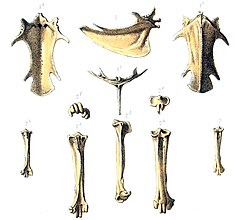
The Rodrigues pigeon, also known as Rodrigues dove is an extinct species of pigeon formerly endemic to the Mascarene island of Rodrigues. It is known from a subfossil sternum and some other bones, and the descriptions of Leguat (1708) and Julien Tafforet (1726).
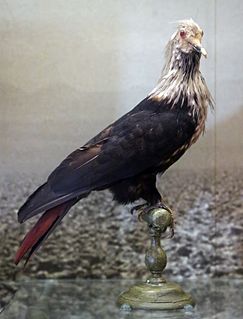
The Mauritius blue pigeon is an extinct species of blue pigeon formerly endemic to the Mascarene island of Mauritius in the Indian Ocean east of Madagascar. It has two extinct relatives from the Mascarenes and three extant ones from other islands. It is the type species of the genus of blue pigeons, Alectroenas. It had white hackles around the head, neck and breast and blue plumage on the body, and it was red on the tail and the bare parts of the head. These colours were thought similar to those of the Dutch flag, a resemblance reflected in its French common name, Pigeon Hollandais. The juveniles may have been partially green. It was 30 cm (12 in) long and larger and more robust than any other blue pigeon species. It fed on fruits, nuts, and molluscs, and was once widespread in the forests of Mauritius.
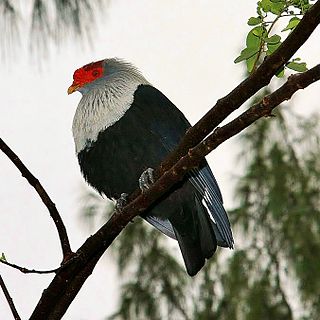
The Seychelles blue pigeon, also known as the Seychelles blue fruit dove, is a medium-sized pigeon which inhabits woodland areas of the granitic Seychelles archipelago.

The blue pigeons are a genus, Alectroenas, of birds in the dove and pigeon family Columbidae. They are native to islands in the western Indian Ocean.
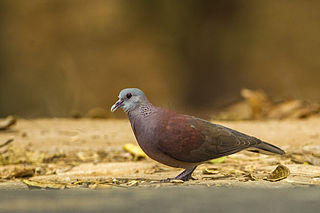
The Malagasy turtle dove is a bird species in the pigeon and dove family, Columbidae. It is found in British Indian Ocean Territory, the Comoros, Madagascar, Mauritius, Mayotte, Réunion, and the Seychelles.

Nesoenas is a bird genus in the pigeon and dove family, Columbidae. It is often included with the typical turtle-doves in Streptopelia or the typical pigeons (Columba). By those who accepted it, it was usually treated as monotypic, containing only the pink pigeon of Mauritius.

Brown doves are members of the genus Phapitreron in the pigeon family. Their common name refers to their overall brown coloration. They are endemic to the Philippines. All brown doves are tree-dwellers, but the different species occupy different types of wooded habitats; some are more restricted to old-growth forest while other make use of secondary forest and other woodland. Their main diet is fruit. They tend to be solitary in their habits and can be elusive. Some species in this genus have conspicuous black and white stripes on their faces and iridescent neck feathers. Males and females look alike.

Julian Pender Hume is an English palaeontologist, artist and writer who lives in Wickham, Hampshire. He was born in Ashford, Kent, and grew up in Portsmouth, England. He attended Crookhorn Comprehensive School between 1971 and 1976. His career began as an artist, specialising in the reconstruction of extinct species, after which he undertook a degree in palaeontology at the University of Portsmouth, followed by a PhD in the same subject, jointly hosted by the University of Portsmouth and the Natural History Museum, London and Tring. He is presently a Research Associate at the Natural History Museum, and has travelled extensively, working on fossil excavations that include the Cape Verde Islands; Lord Howe Island, Tasmania, Flinders, King and Kangaroo Islands, Australia; Madagascar, Seychelles, and Hawaiian Islands. However, his main area of research is the Mascarene Islands of Mauritius, Réunion, and Rodrigues, where in particular he has studied the history of the dodo.
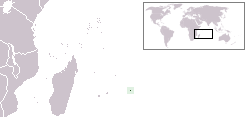
The Rodrigues blue pigeon is an extinct species of blue pigeon which was endemic to Rodrigues. It is known only from the holotype tarsometatarsus collected in 2005, associated with remains of a Rodrigues night heron and a Rodrigues rail. A femur described in 1879 but now lost may also have belonged to the species. It was not specifically mentioned by contemporary writers, and it is therefore unknown when it became extinct.

The Mare aux Songes swamp is a lagerstätte located close to the sea in south eastern Mauritius. Many subfossils of recently extinct animals have accumulated in the swamp, which was once a lake, and some of the first subfossil remains of dodos were found there.

The Mauritian wood pigeon is an extinct species of the pigeon genus Columba which was endemic to Mauritius. The holotype is a right tarsometatarsus collected in 1910 by Etienne Thirioux.

Columbinae is a subfamily of birds from the family Columbidae. Otherwise, four genera Geotrygon, Leptotila, Starnoenas and Zenaida form subfamily Leptotilinae.


















